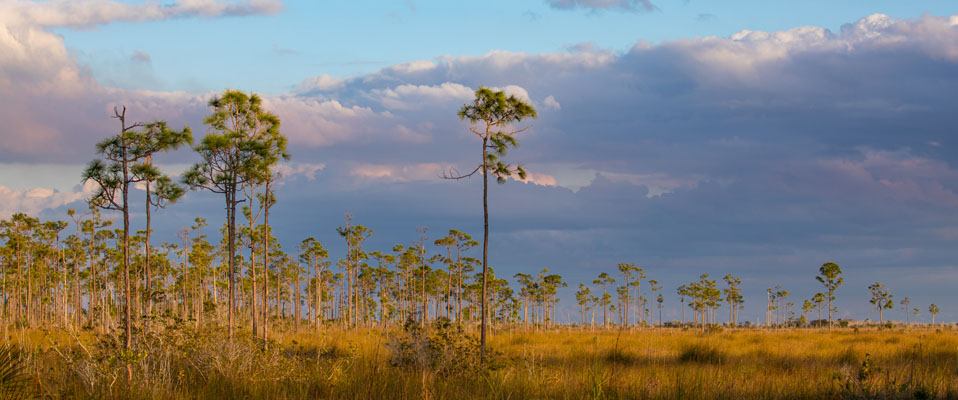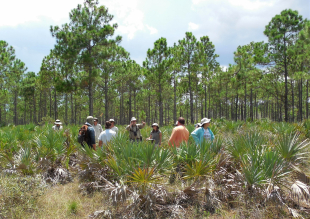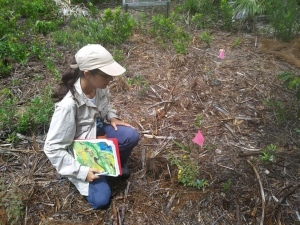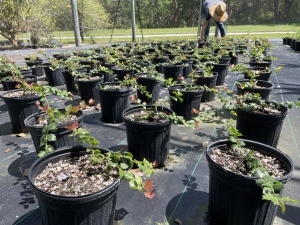Native Plant Conservation

Native plant conservation at Fairchild is conducted by the Conservation Team: a group of experts who monitor, research, and grow plants native to South Florida and the Caribbean. Our program objective is to decrease the extinction risk of our local flora. We have accomplished so much since our program began in the 1980s. If you would you like to get involved, please consider joining our Native Plant Network!
Read on to learn more about our program and the plants we are conserving.
Reintroductions
Fairchild plays an important role in the conservation of South Florida’s endangered plants through rare plant reintroductions. Since 1991, we have facilitated 88 reintroductions of 26 species. We design reintroductions as experiments, so that while we are returning a native species to the wild, we are also learning about its ecology. Some of the species for which we have conducted multiple reintroductions include Amorpha herbacea var. crenulata, Jacquemontia reclinata, and Pilosocereus robinii (pictured).

Seed research
Seeds are a major component of our rare plant collections, as stored seeds require few resources, but can be sown to provide plants for reintroduction or research. Since seed storage behavior of subtropical species is difficult to predict, we often conduct experimental trials to help determine optimal seed storage requirements for these species. If seeds are determined to be “orthodox” (good candidates for storage), they are kept in our on-site seed bank and/or sent to the USDA’s National Laboratory for Genetic Resources Preservation.
Click here for an inventory of Fairchild’s conservation seed bank
Click here for seed propagation protocols for 20 pine rockland species
Management planning
Conservation biology is challenging in South Florida, where rapid urban development has nearly wiped out some of the world’s most imperiled ecosystems like pine rockland, hardwood hammock, and coastal dunes. Fairchild’s Conservation Team works closely with managers of Miami-Dade County preserves, Broward County parks, and others to research the relationships between native South Florida plants and their ecosystems, especially in regard to best management and effective restoration practices. Scroll down to our list of publications for recent management plans and more.

Field biology
Fairchild’s Conservation Team has a deep appreciation for nature in subtropical South Florida, where our flora and fauna are heavily influenced by those of the West Indies. Most days, we are out and about in one of South Florida’s amazing natural areas like the Environmentally Endangered Lands preserves in Miami-Dade County, parks in Broward County, Florida State Parks, Everglades National Park, Biscayne National Park, and more. Incredibly, new discoveries can still happen, right in our own back yards!

Conservation horticulture
Growing native plants is a critical component of our conservation work. In addition to growing plants for reintroductions, restorations, the Native Plant Network, and Fairchild plant sales, we care for a portion of the US National Collection with support from the Center for Plant Conservation. At any given time, our extensive nursery collections are likely to include more than ten federally listed species from Florida, Puerto Rico, and the US Virgin Islands, as well as dozens of state-listed and even common native species.

Rare plant propagation is a mix of art and science that can be challenging! Propagation protocols for some of our native species are available at the links below; we intend to add more protocols as we can.
Bourreria cassinifolia (Little strongbark) propagation
Croton linearis (Pineland croton) propagation
Muhlenbergia capillaris (Muhly grass) propagation
Schizachyrium sanguineum (Crimson bluestem) propagation
Zamia integrifolia (Coontie) propagation
Conservation team

Jennifer Possley, MS | Director of Regional Conservation
Jimmy Lange, MS | Research Botanist
Brian Harding | Conservation Horticulturist
Noah Frade, MS | Project Biologist
Nick Matsumoto, MS | Seed Bank Curator
Andrea Mirow | EEL (Environmentally Endangered Lands) Outreach Coordinator
Riki Bonnema | MDC Botanist
Daniela Champney | Native Plant Network Manager
Kyra Wells | Program Assistant
Research associates | Erick Revuelta, MS, Lindsey Riibe, Lauren Trotta, Ph.D., Steve Woodmansee
Nursery & field volunteers | Maria D., Mary, Ray, Jim, Pedro, Sharyn, Joanne, Carol, Isabel, Lisa, Richard, Scott, June, Gisele, Ashley, Cathy, Kyra, Adair, Lourdes, Eleanor, and Maria G.
Email us:
General questions and volunteering: Amirow@fairchildgarden.org
Donations and research: JPossley@fairchildgarden.org
Native Plant Network: NPN@fairchildgarden.org
Funding
Fairchild’s Conservation Team is funded by grants from local, state and federal agencies, as well as by private donors. Donations are critical to our program. You can donate online with a credit card by clicking the button below. For questions or comments about donating to the program please contact Jennifer Possley at jpossley@fairchildgarden.org.
Thank you to our recent financial supporters, including:
Florida Dept. of Agriculture and Consumer Services
Florida’s Endangered Plant Advisory Council
Miami-Dade County Environmentally Endangered Lands (EEL) Program
Miami-Dade County Parks, Recreation & Open Spaces
US Fish and Wildlife Service
University of Florida McGuire Center
US National Park Service
The Center for Plant Conservation
Broward County Parks and Recreation
Institute for Regional Conservation
Individual private donors
Select recent reports, publications and field guides:
- Albrecht et al. (2018). Effects of life history and reproduction on recruitment time lags in reintroductions of rare plants.
- Lange & Angelo (2020). Goniopteris moranii, new to the United States.
- Maschinski et al. (2018). Improving success of rare plant seed reintroductions: a case study of Dalea carthagenensis var. floridana, a rare legume with dormant seeds.
- Possley et al. (2018) Miami-Dade County Management Plan for the Richmond Pine Rocklands.
- Possley (2021) Guide to ferns of Miami-Dade (revised)
- Salazar et al. (2018) Seed germination of 53 species from the globally critically imperiled pine rockland ecosystem of South Florida.
Photo credits:
Banner image by Haniel Pulido, www.falconshots.com
Seed images by Jack Hahn, in Fairchild’s imaging Lab
Other photos by Jennifer Possley and Marlon Rumble
